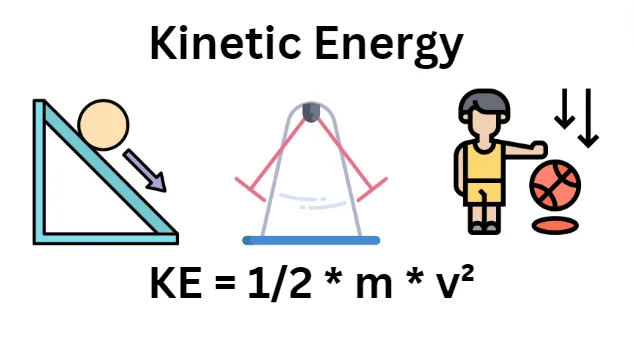Kinetic energy is one of the most fundamental concepts in physics, playing a crucial role in understanding motion. From a moving car to a flying bird, everything that is in motion possesses kinetic energy. In this article, we’ll explore the definition, formula, types, and applications of kinetic energy, along with practical examples to help you understand this vital concept.
What is Kinetic Energy?
Kinetic energy is the energy an object possesses due to its motion. The faster an object moves or the heavier it is, the more kinetic energy it has. It is a scalar quantity, which means it only has magnitude and no direction. Kinetic energy is one of the two main types of mechanical energy, the other being potential energy.
The concept of kinetic energy is tied to the work-energy principle, which states that the work done on an object results in a change in its kinetic energy. The more work performed to accelerate an object, the more its kinetic energy increases.
Kinetic Energy Formula
The formula for calculating kinetic energy (KEKE) is straightforward:
KE=12mv2KE = \frac{1}{2}mv^2
Where:
KEKE = Kinetic energy (in joules, J)
mm = Mass of the object (in kilograms, kg)
vv = Velocity of the object (in meters per second, m/s)
Key Factors Affecting Kinetic Energy
Mass: The mass of an object directly affects its kinetic energy. A heavier object moving at the same speed as a lighter object will have more kinetic energy. For example, a truck moving at 60 mph has more kinetic energy than a bicycle moving at the same speed due to its greater mass.
Speed: The speed of an object has a much larger impact on its kinetic energy. Since the velocity is squared in the formula, doubling an object’s speed results in a fourfold increase in its kinetic energy. This is why fast-moving vehicles or objects can cause significantly more damage in accidents.
Direction of Motion: Kinetic energy does not depend on the direction of motion but only on the speed of the object. Therefore, two objects moving in opposite directions at the same speed will have the same kinetic energy.
Types of Kinetic Energy
Translational Kinetic Energy: This is the energy possessed by an object moving in a straight line. For example, a car driving down a highway has translational kinetic energy.
Rotational Kinetic Energy: Objects that rotate about an axis also have kinetic energy, which depends on their rotational velocity and moment of inertia. A spinning wheel or a rotating turbine has rotational kinetic energy.
Vibrational Kinetic Energy: In objects that oscillate or vibrate, such as a vibrating string or the molecules in a gas, vibrational kinetic energy comes into play. The faster the oscillations, the higher the kinetic energy.
Real-Life Applications of Kinetic Energy
Kinetic energy is present all around us, and understanding how it works can provide insights into everyday phenomena. Here are some practical applications:
Transportation: Vehicles, from cars to airplanes, convert fuel into kinetic energy. The faster they move, the more kinetic energy they have. For instance, high-speed trains rely on kinetic energy for quick and efficient transportation.
Wind Energy: Wind turbines convert the kinetic energy of moving air into electricity. The wind’s kinetic energy is captured by the blades of the turbine and then transformed into mechanical energy to generate power.
Sports: In sports, kinetic energy plays a key role. When a baseball is hit, it acquires kinetic energy, which allows it to travel through the air. The speed and mass of a player’s movement also determine how much kinetic energy they generate while running or jumping.
Hydropower: Water flowing through rivers or dams possesses kinetic energy. When the water moves through turbines, this kinetic energy is converted into electrical energy, powering homes and businesses.
Collisions and Accidents: Kinetic energy is a crucial factor in understanding the severity of collisions. When two objects collide, the kinetic energy of both objects is either transferred or transformed into other energy forms, such as heat or sound. This is why high-speed crashes are more destructive—they involve larger amounts of kinetic energy.
Friction and Braking Systems: Braking systems in cars, bicycles, and airplanes convert kinetic energy into heat via friction. This energy dissipation is essential for stopping the vehicle.
The Law of Conservation of Kinetic Energy
Kinetic energy is governed by the law of conservation of energy, which states that energy cannot be created or destroyed, only converted from one form to another. In a closed system, the total kinetic energy before and after a collision or interaction remains constant, although some of the energy may be converted to other forms such as sound or heat.
However, in inelastic collisions, some kinetic energy is converted into other forms of energy, which is why objects involved in such collisions might not rebound with the same speed they had before impact.
Kinetic Energy and Safety
Kinetic energy is a key factor in safety considerations. For instance, car manufacturers design safety features like airbags and crumple zones to absorb the kinetic energy of collisions, protecting passengers from injury. Similarly, sports equipment like helmets and padding work by absorbing kinetic energy during impact.
Conclusion
Kinetic energy is an essential concept in physics that explains the energy of motion. Whether it’s a vehicle on the road, the wind generating power, or an athlete running a race, kinetic energy is everywhere. Its relationship with mass and speed means that even small changes in these variables can have a significant impact on the energy involved. Understanding kinetic energy not only helps in the study of physics but also has practical applications in various industries such as transportation, energy production, and safety.


















